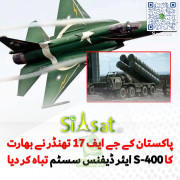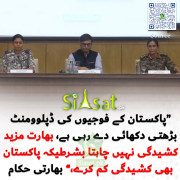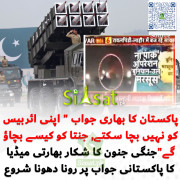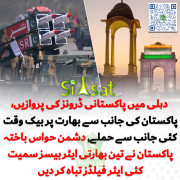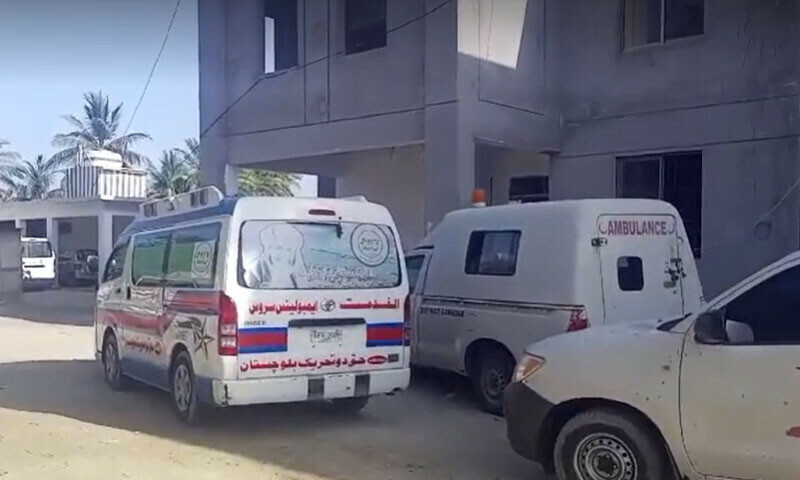A
You are using an out of date browser. It may not display this or other websites correctly.
You should upgrade or use an alternative browser.
You should upgrade or use an alternative browser.
More options
Promote your thread
A
arshad_lahore
Guest
A
arshad_lahore
Guest
A
arshad_lahore
Guest
A
arshad_lahore
Guest
A
arshad_lahore
Guest
A
arshad_lahore
Guest
A
arshad_lahore
Guest
A
arshad_lahore
Guest
A
arshad_lahore
Guest
A
arshad_lahore
Guest
A
arshad_lahore
Guest
A
arshad_lahore
Guest
A
arshad_lahore
Guest
A
arshad_lahore
Guest
A
arshad_lahore
Guest
A
arshad_lahore
Guest
A
arshad_lahore
Guest
A
arshad_lahore
Guest
Swat operation and the fallout beyond
Tuesday, June 09, 2009
Rahimullah Yusufzai
Though the armed forces are carrying out operations against Taliban primarily in Swat, Buner and Lower Dir, the fallout of the action in neighbouring districts and beyond should remain a matter of concern. Dislocated from their bases and scattered as a result of the army assault, the militants are finding sanctuaries in new places and striking in areas outside their traditional strongholds.
This reminds one of Afghanistan in the pre- and post-9/11 period. Prior to the US invasion of the country in October 2001, Al Qaeda was headquartered in Taliban-ruled Afghanistan. Following the fall of Taliban regime, Osama bin Laden and his men lost most of their sanctuaries in Afghanistan and had to relocate elsewhere. Most came to neighbouring Pakistan, from where some of them embarked on a risky journey to their native countries or to new trouble-spots such as Iraq. The majority stayed put in the region, mostly in the border areas of Afghanistan and Pakistan, and became a threat to the governments in Kabul and Islamabad by making and strengthening alliance with like-minded militant groups in the two countries. Rather than being contained, Al Qaeda and the Taliban spread their influence beyond borders and become an even bigger threat to the established order than they were when well-entrenched in Afghanistan during the 1994-2001 period. It also became difficult to apprehend them as they were no longer confined to one place and country.
Upper Dir, which became a separate district when Dir was split into two some years ago, is part of Malakand division but it wasn't supposed to be an active front in the ongoing military operations. But it is fast becoming one due to Taliban activities in the remote Dhog Darra area. The security forces have already bombed the few villages where the Afghan Taliban got refuge and built sanctuaries. Troops also moved artillery batteries to the Khal area to fire at Taliban hideouts in the adjoining Swat valley. Gradually, Upper Dir was getting engulfed in the military action. However, the situation deteriorated following the recent suicide bombing in a mosque during Friday prayers at the Hayagai Sharqi village. The death of 50 villagers, including children, in the attack could have provoked anyone to take revenge. And that is what the aggrieved villagers and their allies are now doing, raising a lashkar, or armed volunteer force, and storming the three pro-Taliban villages - Shatkas, Ghazigay and Salambekay -, because they are convinced the suicide bomber came from there. After months of social boycott of these villagers and clashes, the majority anti-Taliban villages are now bent upon settling scores with the enemy.
For obvious reasons, the government is taking no step to stop the fighting. Instead, it seems to be encouraging or could even be supporting the lashkar to go for the kill. This is the kind of battle that is fuelled by new blood-feuds and is never-ending until one side is vanquished and forced to accept the terms of surrender. Heavily-armed villages and clans hostile to each other cannot co-exist in peace, more so if they are supported and supplied by the government or militant groups such as Taliban. In the past also, the government has backed similar anti-Taliban lashkars in Swat, Buner, Bajaur, Orakzai, Darra Adamkhel and other places. Such a policy has generally caused lot of bloodshed and sowed the seeds of turmoil. The Taliban have ruthlessly retaliated by sending suicide bombers to attack jirgas of tribal elders and clerics hostile to them in Darra Adamkhel, Bajaur and Orakzai or causing harm to anyone in sight and terrorizing entire villages as was the case in Shalbandai in Buner, Hayagai Sharqi in Upper Dir and Mandaldag in Swat where the late anti-Taliban commander Pir Samiullah had dared to raise a lashkar against them.
The Shangla district, lacking a strong civil administration and police, had always been vulnerable to incursions by the militants. However, it never had a strong Taliban presence. Even now most of the Taliban fighters gathered in its Puran and Chakesar areas came from Swat and Buner or crossed over from the mountainous Kala Dhaka, or Torghar area, in Mansehra district. Shangla residents are now suffering and getting displaced due to the Taliban's decision to set up roadside checkpoints or use the district as a hideout for its retreating cadres. If pushed further, they would cross over to Kala Dhaka and Battagram, where the militants have recently carried out attacks against the police and exploded bombs. Other parts of Mansehra district including Shinkiari and Oghi too have experienced terrorist strikes as part of the fallout of the situation in Swat, Buner and Shangla. Kohistan, another district of Hazara, could meet the same fate as a few hundred Kohistani militants operating in Swat's Kalam and Bahrain tehsils have reportedly returned home to escape an onslaught by the security forces. They may not sit idle for long and some of them could become active upon receiving instructions from their commanders, who presently are in disarray.
Though Malakand Agency is part of Malakand division, it didn't fall into the category of the Taliban-infested Swat, Buner and Lower Dir districts where active military operations were planned. However, the militants have struck a few times in Malakand Agency, where the poorly-armed and trained Malakand Levies were deployed until now to provide a semblance of security to the people. The main road to Swat and rest of Malakand division passes through the Malakand Agency and curfew has to be frequently imposed to protect military convoys using the Mardan-Malakand-Chakdarra-Mingora road. The militants are finding it tempting to attack the army convoys using this busy road. Though there is controversy regarding the recent incident in Sakhakot, a town in Malakand Agency, in which the army says the detained TNSM leaders Maulana Mohammad Alam and Amir Izzat Khan were killed along with a soldier in an attack by the militants, it nevertheless showed the vulnerability of the troops to such attacks on this critical route. By the way, the government would have to do a lot more to clear the doubts regarding the killing of the two TNSM leaders, who were in custody of the security forces and hadn't been charged for any crime. The uncertainty about the whereabouts of the TNSM head Maulana Sufi Mohammad also needs to be cleared because the death and detention of Islamic leaders waging peaceful struggle for Shariah could complicate matters and push their followers to join forces with the Taliban.
More worrying are the Taliban incursions into districts outside Malakand division. Mardan is the prime target for the Taliban due to its proximity to both Buner and Swat. As host of the biggest number of internally displaced persons (IDPs) both in and outside the camps, it has received its share of disguised militants waiting for an opportunity to strike back at the security forces and law-enforcement agencies. The recent attack, which employed the classic guerilla tactic of planting and exploding an improvised explosives device (IED) to target a military convoy and then ambushing the troops and police sent as reinforcements, on the Rustam-Buner road showed how crucial has Mardan district become in tackling the militants and stabilizing Buner as well as Swat. Up to 10 soldiers and cops were killed in this attack, which explained how quickly the Swati and Buneri Taliban using local militants adapted themselves to the changed circumstances and planned and executed a deadly strike.
Similar attacks could take place in Swabi, Charsadda, Nowshera and even Peshawar, all part of the vast and fertile Peshawar valley where the battle against militancy and extremism is gradually shifting and where its fate could be eventually decided. In fact, the Peshawar valley is also facing fallout of the military action in the tribal areas of Bajaur, Mohmand, Khyber, Orakzai and Darra Adamkhel. It is here that the political elite of the province lives and where the big army garrisons, seat of the government and the commercial hubs are located. By destabilizing the vale of Peshawar, the militants would be hoping to paralyze the government and consolidate their hold in Waziristan and other tribal areas in the south and in Malakand division in the north of the province.
The writer is resident editor of The News in Peshawar.
Tuesday, June 09, 2009
Rahimullah Yusufzai
Though the armed forces are carrying out operations against Taliban primarily in Swat, Buner and Lower Dir, the fallout of the action in neighbouring districts and beyond should remain a matter of concern. Dislocated from their bases and scattered as a result of the army assault, the militants are finding sanctuaries in new places and striking in areas outside their traditional strongholds.
This reminds one of Afghanistan in the pre- and post-9/11 period. Prior to the US invasion of the country in October 2001, Al Qaeda was headquartered in Taliban-ruled Afghanistan. Following the fall of Taliban regime, Osama bin Laden and his men lost most of their sanctuaries in Afghanistan and had to relocate elsewhere. Most came to neighbouring Pakistan, from where some of them embarked on a risky journey to their native countries or to new trouble-spots such as Iraq. The majority stayed put in the region, mostly in the border areas of Afghanistan and Pakistan, and became a threat to the governments in Kabul and Islamabad by making and strengthening alliance with like-minded militant groups in the two countries. Rather than being contained, Al Qaeda and the Taliban spread their influence beyond borders and become an even bigger threat to the established order than they were when well-entrenched in Afghanistan during the 1994-2001 period. It also became difficult to apprehend them as they were no longer confined to one place and country.
Upper Dir, which became a separate district when Dir was split into two some years ago, is part of Malakand division but it wasn't supposed to be an active front in the ongoing military operations. But it is fast becoming one due to Taliban activities in the remote Dhog Darra area. The security forces have already bombed the few villages where the Afghan Taliban got refuge and built sanctuaries. Troops also moved artillery batteries to the Khal area to fire at Taliban hideouts in the adjoining Swat valley. Gradually, Upper Dir was getting engulfed in the military action. However, the situation deteriorated following the recent suicide bombing in a mosque during Friday prayers at the Hayagai Sharqi village. The death of 50 villagers, including children, in the attack could have provoked anyone to take revenge. And that is what the aggrieved villagers and their allies are now doing, raising a lashkar, or armed volunteer force, and storming the three pro-Taliban villages - Shatkas, Ghazigay and Salambekay -, because they are convinced the suicide bomber came from there. After months of social boycott of these villagers and clashes, the majority anti-Taliban villages are now bent upon settling scores with the enemy.
For obvious reasons, the government is taking no step to stop the fighting. Instead, it seems to be encouraging or could even be supporting the lashkar to go for the kill. This is the kind of battle that is fuelled by new blood-feuds and is never-ending until one side is vanquished and forced to accept the terms of surrender. Heavily-armed villages and clans hostile to each other cannot co-exist in peace, more so if they are supported and supplied by the government or militant groups such as Taliban. In the past also, the government has backed similar anti-Taliban lashkars in Swat, Buner, Bajaur, Orakzai, Darra Adamkhel and other places. Such a policy has generally caused lot of bloodshed and sowed the seeds of turmoil. The Taliban have ruthlessly retaliated by sending suicide bombers to attack jirgas of tribal elders and clerics hostile to them in Darra Adamkhel, Bajaur and Orakzai or causing harm to anyone in sight and terrorizing entire villages as was the case in Shalbandai in Buner, Hayagai Sharqi in Upper Dir and Mandaldag in Swat where the late anti-Taliban commander Pir Samiullah had dared to raise a lashkar against them.
The Shangla district, lacking a strong civil administration and police, had always been vulnerable to incursions by the militants. However, it never had a strong Taliban presence. Even now most of the Taliban fighters gathered in its Puran and Chakesar areas came from Swat and Buner or crossed over from the mountainous Kala Dhaka, or Torghar area, in Mansehra district. Shangla residents are now suffering and getting displaced due to the Taliban's decision to set up roadside checkpoints or use the district as a hideout for its retreating cadres. If pushed further, they would cross over to Kala Dhaka and Battagram, where the militants have recently carried out attacks against the police and exploded bombs. Other parts of Mansehra district including Shinkiari and Oghi too have experienced terrorist strikes as part of the fallout of the situation in Swat, Buner and Shangla. Kohistan, another district of Hazara, could meet the same fate as a few hundred Kohistani militants operating in Swat's Kalam and Bahrain tehsils have reportedly returned home to escape an onslaught by the security forces. They may not sit idle for long and some of them could become active upon receiving instructions from their commanders, who presently are in disarray.
Though Malakand Agency is part of Malakand division, it didn't fall into the category of the Taliban-infested Swat, Buner and Lower Dir districts where active military operations were planned. However, the militants have struck a few times in Malakand Agency, where the poorly-armed and trained Malakand Levies were deployed until now to provide a semblance of security to the people. The main road to Swat and rest of Malakand division passes through the Malakand Agency and curfew has to be frequently imposed to protect military convoys using the Mardan-Malakand-Chakdarra-Mingora road. The militants are finding it tempting to attack the army convoys using this busy road. Though there is controversy regarding the recent incident in Sakhakot, a town in Malakand Agency, in which the army says the detained TNSM leaders Maulana Mohammad Alam and Amir Izzat Khan were killed along with a soldier in an attack by the militants, it nevertheless showed the vulnerability of the troops to such attacks on this critical route. By the way, the government would have to do a lot more to clear the doubts regarding the killing of the two TNSM leaders, who were in custody of the security forces and hadn't been charged for any crime. The uncertainty about the whereabouts of the TNSM head Maulana Sufi Mohammad also needs to be cleared because the death and detention of Islamic leaders waging peaceful struggle for Shariah could complicate matters and push their followers to join forces with the Taliban.
More worrying are the Taliban incursions into districts outside Malakand division. Mardan is the prime target for the Taliban due to its proximity to both Buner and Swat. As host of the biggest number of internally displaced persons (IDPs) both in and outside the camps, it has received its share of disguised militants waiting for an opportunity to strike back at the security forces and law-enforcement agencies. The recent attack, which employed the classic guerilla tactic of planting and exploding an improvised explosives device (IED) to target a military convoy and then ambushing the troops and police sent as reinforcements, on the Rustam-Buner road showed how crucial has Mardan district become in tackling the militants and stabilizing Buner as well as Swat. Up to 10 soldiers and cops were killed in this attack, which explained how quickly the Swati and Buneri Taliban using local militants adapted themselves to the changed circumstances and planned and executed a deadly strike.
Similar attacks could take place in Swabi, Charsadda, Nowshera and even Peshawar, all part of the vast and fertile Peshawar valley where the battle against militancy and extremism is gradually shifting and where its fate could be eventually decided. In fact, the Peshawar valley is also facing fallout of the military action in the tribal areas of Bajaur, Mohmand, Khyber, Orakzai and Darra Adamkhel. It is here that the political elite of the province lives and where the big army garrisons, seat of the government and the commercial hubs are located. By destabilizing the vale of Peshawar, the militants would be hoping to paralyze the government and consolidate their hold in Waziristan and other tribal areas in the south and in Malakand division in the north of the province.
The writer is resident editor of The News in Peshawar.
A
arshad_lahore
Guest
Still no escape from hell
Tuesday, June 09, 2009
Noreen Haider
Post-operation footage of Mingora and other parts of Swat is now being shown by the ISPR in its media briefings, and I honestly don't know what I am supposed to feel looking at the images of the now "cleared" areas. The DGPR and the information minister declare that there are no militants left in the wake of a highly successful military action, "Rah-e-Rast," and that the area is now secure. There are good reasons to doubt that, but even if that is true, the very sorry fact is that there is little else that is left in the wake of the military operation in most of Swat.
I don't know if I'm supposed to feel triumphant and cheer for the army or feel horrified at the images of the totally ravaged towns reduced to rubble.
I have been a strong advocate of destroying the terrorist networks and crushing them completely. I was always for a decisive action against the militants, but the horrific fact is that in doing so the military action has totally destroyed the very area and people it was supposed to protect.
What has become of the militants is yet unclear. Have most of them been killed? How many of them were there, to begin with? Have they run off to some other mountains or caves? What happens to their bodies once they are killed? Who identifies them with usually Arab-sounding names, "Abu something" or the other? We have not yet seen any proof of the number of dead militants or "bodies of the second- and third-level leadership of Taliban/militants" claimed by the army to have been killed, but what we have seen is the undeniable proof of the destruction and devastation of the people of Swat who have become displaced in millions.
The military operation is in full swing and the army is now pounding on the mountains and vallies of Swat with heavy artillery and helicopter gunships in search of militants' hideouts. Although it is true that the army has also suffered causalities and lost officers and jawans, but it is also true that there has been immense collateral damage to civilians, which nobody is supposed to talk about. Does it really matter in the end whose rocket actually destroyed the home of an innocent civilian?
The armed conflict and resulting military operation have destroyed more than just the infrastructure of the towns; it has actually destroyed the very fabric of the society in that culture. It has destroyed whatever sources of livelihood the local population had. It has destroyed the homes, markets, schools, mosques, hotels, water sources, agriculture, standing crops, livestock and trade. The infrastructure might be rebuilt again, but how would entire lives be built again from scratch is the million-dollar question.
According to the latest UN report, as of May 27 there are now over 2.5 million IDPs registered in the six affected NWFP districts, 167,565 of them living in established camps and 2.3 million in other accommodations. According to the NWFP government, the figure is now three million. The "cleaned" NADRA list of registered IDPs states the count at 1.6 millions.
The IDPs in the camps are the most vulnerable who had nowhere to turn to and they are totally dependent on state help. The ones with friends and families are not much better off either.
Over the past week, over 100,000 IDPs have moved into some 1,800 vacant schools in five districts. The largest influx is in Mardan district. Water and sanitation conditions in the camps are deteriorating fast and urgent attention is needed to prevent the spread of waterborne diseases. Women and children are the most vulnerable, especially the ones that are not accompanied by their men folks. These are almost always marginalised in terms of relief distribution and special needs. It is vitally important that camp mangers must be instructed by the government of focus on these vulnerable groups and give special consideration to their needs. It is heart wrenching to see that many of these unaccompanied women have actually lost their menfolk in this conflict and they are in mourning but because of the situation befallen them they are not even able to grief for their loss. I met a mother of six at Jalala camp whose husband had died before her eyes 25 days previously before they could make their escape from Mingora, but she was too shocked to even cry. She told her story dry-eyed and asked for some lighter clothes for her children as it was so hot.
The host families of the IDPs too are now at the rope's end. The UNHCR has already declared that if the international community does not chip in very soon they will have to stop their operation in one month. The IDPs need assistance immediately. If the government doesn't speed up its sluggish relief efforts soon, it could precipitate an even bigger disaster. It is important for the government to remember that the IDPs did not leave their homes of their own sweet will; they were forced to leave by the policy and strategy of the government. Therefore, the government is responsible to start taking care of them without a single moment's delay.
The government is still unclear about the IDPs policy, which it is yet to announce. It has made no plans to reach out to the off-camp IDPs in an effective manner. The government is dependent on the UNHCR for distribution of non-food items to off-camp IDPs, but has no countercheck to monitor how effectively it's being done, if at all. The DCOs of the host districts do not have any data of the quantity of non-food items being distributed by the UNHCR, nor are they authorised to distribute any of the items themselves. The result is that there are many relief items stocked in government warehoused which cannot be distributed to in-camp or off-camp IDPs, except by the UNHCR.
So it's again the IDPs who are at the receiving end of operational hiccups and delays. The government warehouses in Mardan are stacked with the required items which the district government has to hold till it is distributed by the UNHCR. However, relief items are being distributed by people on their own, in an irregular manner.
The sanitary conditions in the camps are getting worse by the day. The Tehsil Municipal Administration was supposed to provide sanitary workers for providing cleaning facilities but they are not deputed in sufficient numbers with the result that the camps are stinking and the worsening hygiene conditions could lead to disease and even epidemic like diarrhoea and cholera.
The federal minister for information and broadcast has announced that to-date the government has received $230 million in aid but the three-phase plan for relief, rehabilitation and reconstruction is still not ready.
The IDPs of Malakand and other areas are still waiting for any substantial help from the government. It is more than plastic buckets or flour bags that they need. The government must immediately chalk out a plan for their rehabilitation in their own areas. If the statements of the ISPR are correct and parts of Malakand are actually secure, then the IDPS must be moved back to their own hometowns and provided assistance there, rather than be kept rotting in camps and makeshift shelters.
The writer has extensive experience of research and monitoring in disasters and is currently working as member social sector in the chief minister's monitoring and implementation cell in Punjab.
Tuesday, June 09, 2009
Noreen Haider
Post-operation footage of Mingora and other parts of Swat is now being shown by the ISPR in its media briefings, and I honestly don't know what I am supposed to feel looking at the images of the now "cleared" areas. The DGPR and the information minister declare that there are no militants left in the wake of a highly successful military action, "Rah-e-Rast," and that the area is now secure. There are good reasons to doubt that, but even if that is true, the very sorry fact is that there is little else that is left in the wake of the military operation in most of Swat.
I don't know if I'm supposed to feel triumphant and cheer for the army or feel horrified at the images of the totally ravaged towns reduced to rubble.
I have been a strong advocate of destroying the terrorist networks and crushing them completely. I was always for a decisive action against the militants, but the horrific fact is that in doing so the military action has totally destroyed the very area and people it was supposed to protect.
What has become of the militants is yet unclear. Have most of them been killed? How many of them were there, to begin with? Have they run off to some other mountains or caves? What happens to their bodies once they are killed? Who identifies them with usually Arab-sounding names, "Abu something" or the other? We have not yet seen any proof of the number of dead militants or "bodies of the second- and third-level leadership of Taliban/militants" claimed by the army to have been killed, but what we have seen is the undeniable proof of the destruction and devastation of the people of Swat who have become displaced in millions.
The military operation is in full swing and the army is now pounding on the mountains and vallies of Swat with heavy artillery and helicopter gunships in search of militants' hideouts. Although it is true that the army has also suffered causalities and lost officers and jawans, but it is also true that there has been immense collateral damage to civilians, which nobody is supposed to talk about. Does it really matter in the end whose rocket actually destroyed the home of an innocent civilian?
The armed conflict and resulting military operation have destroyed more than just the infrastructure of the towns; it has actually destroyed the very fabric of the society in that culture. It has destroyed whatever sources of livelihood the local population had. It has destroyed the homes, markets, schools, mosques, hotels, water sources, agriculture, standing crops, livestock and trade. The infrastructure might be rebuilt again, but how would entire lives be built again from scratch is the million-dollar question.
According to the latest UN report, as of May 27 there are now over 2.5 million IDPs registered in the six affected NWFP districts, 167,565 of them living in established camps and 2.3 million in other accommodations. According to the NWFP government, the figure is now three million. The "cleaned" NADRA list of registered IDPs states the count at 1.6 millions.
The IDPs in the camps are the most vulnerable who had nowhere to turn to and they are totally dependent on state help. The ones with friends and families are not much better off either.
Over the past week, over 100,000 IDPs have moved into some 1,800 vacant schools in five districts. The largest influx is in Mardan district. Water and sanitation conditions in the camps are deteriorating fast and urgent attention is needed to prevent the spread of waterborne diseases. Women and children are the most vulnerable, especially the ones that are not accompanied by their men folks. These are almost always marginalised in terms of relief distribution and special needs. It is vitally important that camp mangers must be instructed by the government of focus on these vulnerable groups and give special consideration to their needs. It is heart wrenching to see that many of these unaccompanied women have actually lost their menfolk in this conflict and they are in mourning but because of the situation befallen them they are not even able to grief for their loss. I met a mother of six at Jalala camp whose husband had died before her eyes 25 days previously before they could make their escape from Mingora, but she was too shocked to even cry. She told her story dry-eyed and asked for some lighter clothes for her children as it was so hot.
The host families of the IDPs too are now at the rope's end. The UNHCR has already declared that if the international community does not chip in very soon they will have to stop their operation in one month. The IDPs need assistance immediately. If the government doesn't speed up its sluggish relief efforts soon, it could precipitate an even bigger disaster. It is important for the government to remember that the IDPs did not leave their homes of their own sweet will; they were forced to leave by the policy and strategy of the government. Therefore, the government is responsible to start taking care of them without a single moment's delay.
The government is still unclear about the IDPs policy, which it is yet to announce. It has made no plans to reach out to the off-camp IDPs in an effective manner. The government is dependent on the UNHCR for distribution of non-food items to off-camp IDPs, but has no countercheck to monitor how effectively it's being done, if at all. The DCOs of the host districts do not have any data of the quantity of non-food items being distributed by the UNHCR, nor are they authorised to distribute any of the items themselves. The result is that there are many relief items stocked in government warehoused which cannot be distributed to in-camp or off-camp IDPs, except by the UNHCR.
So it's again the IDPs who are at the receiving end of operational hiccups and delays. The government warehouses in Mardan are stacked with the required items which the district government has to hold till it is distributed by the UNHCR. However, relief items are being distributed by people on their own, in an irregular manner.
The sanitary conditions in the camps are getting worse by the day. The Tehsil Municipal Administration was supposed to provide sanitary workers for providing cleaning facilities but they are not deputed in sufficient numbers with the result that the camps are stinking and the worsening hygiene conditions could lead to disease and even epidemic like diarrhoea and cholera.
The federal minister for information and broadcast has announced that to-date the government has received $230 million in aid but the three-phase plan for relief, rehabilitation and reconstruction is still not ready.
The IDPs of Malakand and other areas are still waiting for any substantial help from the government. It is more than plastic buckets or flour bags that they need. The government must immediately chalk out a plan for their rehabilitation in their own areas. If the statements of the ISPR are correct and parts of Malakand are actually secure, then the IDPS must be moved back to their own hometowns and provided assistance there, rather than be kept rotting in camps and makeshift shelters.
The writer has extensive experience of research and monitoring in disasters and is currently working as member social sector in the chief minister's monitoring and implementation cell in Punjab.
© Copyrights 2008 - 2025 Siasat.pk - All Rights Reserved. Privacy Policy | Disclaimer|


























